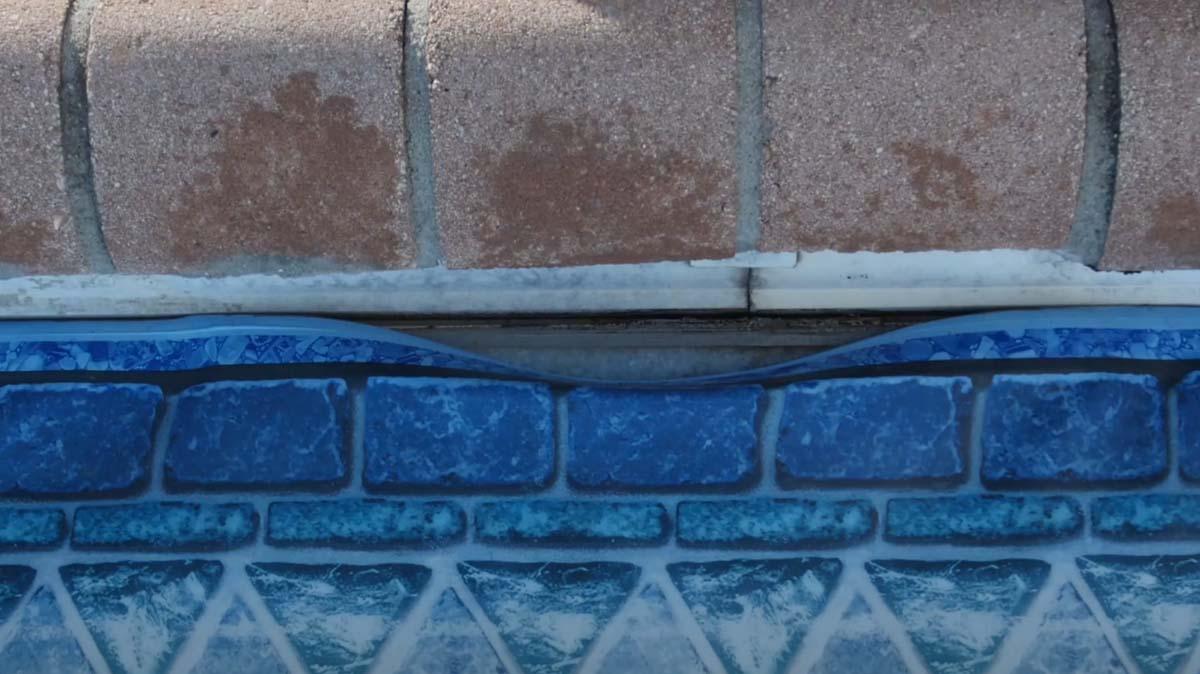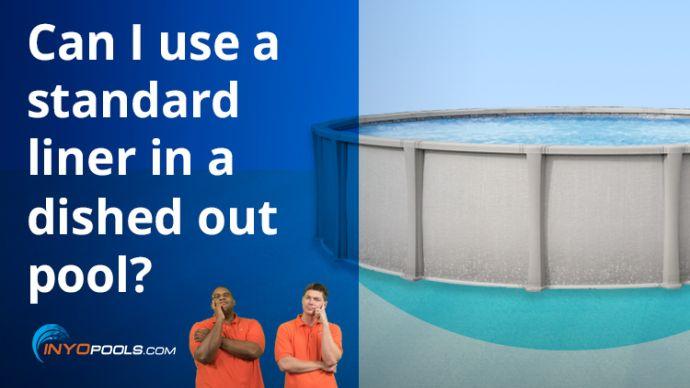
Pool Liner
Troubleshooting
Resources for fixing your liner problems.

Tip: Proper maintenance of your pool liner is essential for preventing leaks and extending its lifespan. Regularly check for any signs of wear, fading, or tears, and address issues promptly to avoid costly repairs. Keep the water level stable to reduce stress on the liner and regularly clean the surface to prevent algae and debris buildup. Additionally, avoid harsh chemicals and sharp objects near the liner. A well-maintained pool liner enhances the appearance of your pool and ensures a safe and enjoyable swimming experience.
Common Liner Problems
Click on a symptom that you are experiencing…
Tears and Rips
Problem:
Tears and rips in pool liners can occur due to various factors, including sharp objects, improper installation, or excessive wear and tear over time. These damages can lead to water loss and may compromise the overall integrity of the pool. Prompt repair is essential to prevent further damage and maintain a safe swimming environment.
Action Items:
- Assess the damage: Inspect the liner carefully to determine the extent and location of the tears or rips. Smaller tears can often be repaired, while larger rips may require a patch or complete replacement.
- Use a patch kit: For small tears, consider using a vinyl patch kit specifically designed for pool liners. Clean the area around the tear, cut a patch slightly larger than the tear, and follow the kit instructions for application.
- Apply vinyl adhesive: For rips or larger tears, apply a strong vinyl adhesive along the edges of the tear before placing the patch. Ensure the adhesive is suitable for underwater application if the repair is made while the pool is filled.
- Avoid sharp objects: To prevent future tears, regularly check the pool area for sharp objects or debris. Ensure that any furniture, toys, or equipment placed in or around the pool is free of sharp edges.
- Consider professional help: If the tear is extensive or if you’re unsure about the repair process, consider hiring a professional pool technician to assess the damage and make the necessary repairs.
Fading or Discoloration
Problem:
Fading or discoloration in pool liners is often caused by prolonged exposure to sunlight, imbalanced water chemistry, or high chlorine levels. While some level of fading is natural over time, extreme discoloration can detract from your pool’s appearance and indicate the need for maintenance adjustments.
Action Items:
- Balance water chemistry: Regularly test and balance your pool’s pH, alkalinity, and chlorine levels. Maintaining proper levels can reduce the likelihood of liner fading caused by high or imbalanced chemicals.
- Use a pool cover: When the pool is not in use, consider using a pool cover to protect the liner from UV rays. This helps prevent fading and also keeps debris out of the pool.
- Avoid direct application of chemicals: Always dissolve chemicals in water before adding them to the pool and avoid pouring them directly onto the liner, which can cause bleach spots and fading.
- Consider periodic shock treatments: If shock treatments are needed, use non-chlorine shock occasionally to avoid excess chlorine exposure on the liner while still maintaining water clarity.
Wrinkles or Bumps
Problem:
Wrinkles or bumps in a pool liner can develop due to water chemistry issues, improper installation, or shifts in the ground beneath the pool. While minor wrinkles are common, larger or spreading wrinkles can affect the pool’s appearance and create areas that trap dirt or debris.
Action Items:
- Drain and reposition: If large wrinkles persist, you may need to partially drain the pool to reposition the liner. Use caution and consult a professional if necessary, as improper drainage and reinstallation can lead to additional wrinkles or liner damage.
- Check for groundwater issues: Excess groundwater beneath the pool can cause the liner to lift and wrinkle. Ensure proper drainage around the pool to prevent water accumulation under the liner.
- Address underlying issues: If the ground has shifted significantly, consider having a pool professional assess the area to determine if further measures, like leveling or reinforcing the pool base, are needed.
Leaking
Problem:
A leaking pool liner can cause water loss, chemical imbalances, and potential structural damage to the pool if left unaddressed. Common causes of leaks include tears, punctures, and worn or separated liner seams. Identifying and addressing the leak quickly is essential to preserving the pool’s liner and maintaining a safe, balanced pool environment.
Action Items:
- Locate the leak: Inspect the liner for visible tears or separations, especially near the seams, corners, and high-traffic areas. Food coloring or a leak-detection kit can help trace the leak by adding dye near suspected areas and observing if it gets drawn to the leak.
- Use a vinyl patch kit: Small tears can be repaired with a vinyl patch kit. Clean and dry the area around the leak, apply the patch, and press it down firmly to ensure it adheres securely. Make sure the patch kit is suitable for underwater use if the pool is filled.
- Monitor water levels: Continue monitoring the water level after the repair to confirm that the leak has stopped. Sudden or continuous water loss may indicate additional leaks or damage that needs further attention.
- Consider professional help for extensive damage: If you cannot locate the leak or if the damage is too extensive for a DIY repair, contact a pool professional for a thorough inspection and repair.
Brittleness or Cracking
Problem:
Brittleness or cracking in a pool liner often occurs due to prolonged exposure to UV rays, fluctuating water chemistry, and age-related wear. This damage can compromise the liner’s integrity, leading to leaks and water loss. Addressing brittleness early helps prolong the liner’s life and keeps the pool in good condition.
Action Items:
- Protect from UV rays: Use a pool cover when the pool is not in use to limit direct sunlight exposure, which can dry out and weaken the liner over time.
- Maintain balanced water chemistry: Regularly test and balance pH, alkalinity, and chlorine levels to prevent chemical damage. Imbalanced water can degrade liner material, making it more susceptible to cracking.
- Avoid high chlorine shock: Over-shocking the pool with chlorine can dry out the liner. Opt for non-chlorine shock treatments when possible to reduce stress on the liner.
- Replace aged liners: Pool liners typically last around 7–10 years. If your liner is older and showing significant brittleness, consider replacing it to prevent further issues.
Stains
Problem:
Stains on a pool liner can be caused by metals, organic matter, or chemical imbalances. They detract from the pool’s appearance and can be stubborn to remove if left untreated. Proper identification of the stain type is key to choosing the right cleaning method.
Action Items:
- Identify the stain source: Check for organic stains (from leaves, algae) versus metal stains (from iron, copper). Organic stains often respond to chlorine, while metal stains require specific treatments.
- Use a vinyl-safe stain remover: For metal-based stains, use a stain remover or sequestrant designed for vinyl liners. Follow instructions carefully to avoid damage.
- Brush and treat organic stains: Regularly brush stained areas and apply shock treatments if the stains are organic. This helps break down organic matter causing discoloration.
- Monitor and adjust water chemistry: Imbalanced water, especially low pH or high metal content, can lead to staining. Aim to keep pH between 7.2 and 7.6 and use a sequestrant if metals are present.
- Prevent future stains: Use a pool cover to keep out debris and a metal sequestrant if your water source contains metals. Regular cleaning and maintenance can help prevent stain buildup.
Liner Out of Track
Problem:
A pool liner that slips out of its track can lead to wrinkles, water leaks, and potential damage if not corrected promptly. This issue often arises due to temperature changes, loose coping, or wear and tear over time.
Action Items:
- Warm the liner: If the liner has contracted in cooler weather, use warm water or a hairdryer (set to low and kept at a safe distance) to gently heat and expand the liner, making it easier to guide back into the track.
- Gently stretch and tuck: Starting at one end of the section that’s out of track, gently stretch the liner and tuck it back into the track using a pool liner lock or the back of a spatula. Take care not to tear or overstretch the liner.
- Use a liner lock or bead wedge: After repositioning, use a vinyl liner lock or bead wedge to help keep the liner in place. This accessory is designed to hold the liner in the track and prevent it from slipping out again.
- Check the track and coping: Inspect the track and coping for damage or looseness, which can cause the liner to slip. Tighten or repair as needed.
- Call a professional if needed: If the liner continues to come out or is difficult to reposition, it may be best to consult a pool professional to avoid further damage.


